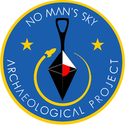Sojainnedy Kibits (Binoscopes Pad)
Andrew Reinhard, 2019. https://doi.org/10.5284/1056629. How to cite using this DOI
Data copyright © Andrew Reinhard unless otherwise stated
This work is licensed under a Creative Commons Attribution 4.0 International License.
Primary contact
Andrew
Reinhard
No Man's Sky Archaeology
Resource identifiers
- ADS Collection: 3558
- DOI:https://doi.org/10.5284/1056629
- How to cite using this DOI
Introduction

Binoscopes Pad, built by player sunaru2 on the planet Sojainnedy Kibits during the Pathfinder era, is an echinocactus farm. Unlike other farms that use hydroponic technology, sunaru2 opted to plant several rows of cactus, which could be harvested every hour as a cash crop to be sold via galactic trade terminal. The crop is sustainable, and is an example of communal farms open to the public to share wealth and resources. Communication stations with words of thanks occupy the original site of the farm several hours' walk distant. This farm is unusual in that after the Atlas Rises cataclysm the planet turned into an "exotic" one with strange geological formations and atmospheric bubbles, unable to sustain life, yet the crops continued to grow. A monument also exists on-site to commemorate the meeting of sunaru2 with another player in a time when human player meetings were very rare and difficult to achieve, also dating to the Pathfinder era.
This is the 19th site visited by Andrew Reinhard for the No Man's Sky Archaeological Project. Upon first arrival, the farm site was occupied only by a central base unit, but no farm. Restarting the game made the farm appear, half-buried, which required excavation. Most communication stations remain buried under bedrock, unable to be excavated and read.





